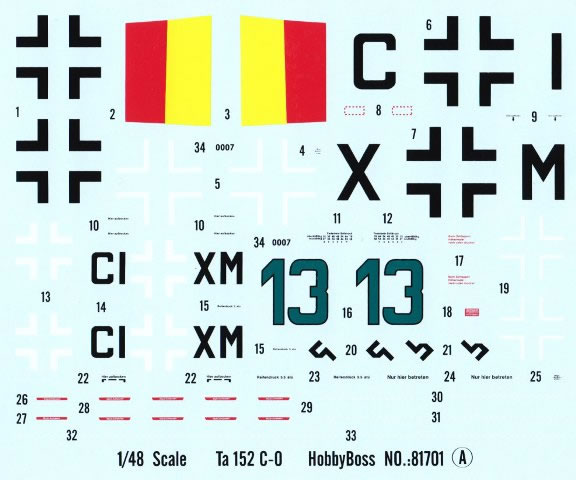Focke-Wulf Ta 152 C-0

HobbyBoss, 1/48 scale
S
u m m a r y |
| Catalogue Number and Description: |
HobbyBoss Kit No. 91701 - Focke-Wuf Ta 152 C-0 |
| Scale: |
1/48 |
| Contents and Media: |
Eight sprues of gray coloured plastic plus a clear tree for the canopy. Markings for two aircraft (one historical; one hypothetical) |
| Price: |
GBP£14.99 available online from Creative Models Limited
|
| Review Type: |
FirstLook |
| Advantages: |
Interesting subject; crisp clean mouldings; finely engraved detail; inclusion of photo etched parts; excellent fit of parts; decals in perfect register with thin carrier film. |
| Disadvantages: |
A couple of detail anomalies. |
| Conclusion: |
Luftwaffe enthusiasts will enjoy this release. It will build into a good replica of the original and will be a pleasure to assemble as well. |
Reviewed by Rob Baumgartner

HobbyBoss' 1/48 scale Ta 152 C-0 is available online from
Squadron
Background
No one really expected a brand new kit of the Ta 152 C-0.
After all, it was a pre-production machine and only three examples were built. They were prototypes V6 “VH+EY”, flown as Ta 152 C-0, V7 “CI+XM” flown as Ta 152 C-0/R11, and V8 “W+QA” flown as Ta 152 C-0/EZ. In the past, modellers wanting to add these aircraft to their collection usually turned to the time-honoured Trimaster/Dragon offering.
So when Hobby Boss announced that they were releasing an example of one of these machines it came as a bit of a surprise.
The Model
Inside the box we find 8 sprues of gray coloured plastic plus a clear tree for the canopy. A fret for photo-etched parts is also present as well as a decal sheet for two options.
The quality of the mouldings is superb with fine recessed panel lines and sharp crisp detail. No sink marks of any consequence were spotted and all parts were fully formed.
As expected, construction starts with the cockpit and most of the usual suspects are represented. The only obvious item needing attention is a more representative rendition of the throttle handle. Instruments are supplied in the form of decals, should you wish to avoid painting them by hand, and the p-e seatbelts are also a nice touch. This latter material can be used for the rudder pedals, rear decking and antenna if you prefer these over their plastic equivalents.

Forward of the wheel well there is the characteristic opening through which one can see the rear engine bay. Hobby Boss gives the builder a good head start and fills this gap to create a “busy” enough look but of course more can always be added by the enthusiast. A dry fit reveals that everything fits snugly between the two fuselage halves.
The single piece lower wing sets up the dihedral nicely with a main spar adding detail and strength. Ailerons, rudder and flaps are all separate items but the builder will have to add some structural detail to the latter. Another trial run reveals no problems at all and the attachment of the wing to the main body is precise.

Two choices of cowling come with the kit and you get to choose between open or closed radiator flaps. The frontal area is a solid moulding but considering that very little is seen with the spinner and prop connected, it won’t bother most modellers.

There are a couple of issues that could be addressed though. The propeller blades fail to portray the “paddle” look of the originals so a little work is necessary here. More is need on the left hand side of the cowl where one finds the hump that allowed clearance for the upper engine support bearer. The top of this contour could do with some softening to more accurately blend it into the upper deck, and the forward covers near the wing root are too prominent and “rectangular”.

Fortunately there are plenty of period photographs of “CI+XM” to guide the builder. With comparison to these, modellers can judge for themselves whether these alterations are worth the effort.
Marking Options
Obviously “CI+XM” is the only historical scheme available for the aircraft so to add some variation, Hobby Boss included a set of fictitious markings. They decided on “green 13” of JG 301 with its colourful red/yellow fuselage bands and RLM 81/82/76 camouflage.

The decals themselves are wonderfully thin and are surrounded by a minimum of carrier film. There is also plenty of stencil data to add and experience reveals that softening solutions are not required.

They do “grab” when applied, so include a drop of dishwashing liquid into the water to help manoeuvre them into position.
This was a surprising and welcome release from Hobby Boss.
As the old Trimaster/Dragon kit is not readily available these days, enthusiasts wanting to model a complete series of Ta 152 aircraft have had look elsewhere...until now. The parts are well moulded, have consistently fine detail, and exhibit a precise fit with very little effort.
The inclusion of alternate photo-etched parts is a bonus and results in a welcome package for all Luftwaffe fans.
Thanks to Creative Models Limited for the sample
Text and Images Copyright © 2011 by Rob Baumgartner
Page Created 31 August, 2011
Last updated
1 September, 2011
Back to HyperScale Main Page

|
